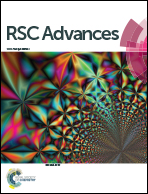Synthesis of carbohydrate polymer encrusted gold nanoparticles using bacterial exopolysaccharide: a novel and greener approach†
Abstract
In the present study, a marine sponge-associated endosymbiotic bacterium Bacillus megaterium MSBN04 was evaluated for exopolysaccharide (EPS) production. The production process was optimized by central composite design (CCD). The productivity was increased up to 5.62 g L−1 with sucrose as sole carbon source. The secreted EPS was characterized by NMR analysis, confirming the presence of monosaccharide units such as α-D-glucose and α-D-galactose, which further confirms that the secreted EPS is a heteropolysaccharide. The purified EPS showed considerable flocculating activity (45.41%) with 4 mg L−1 of EPS. Using EPS as reducing and stabilizing agent, gold nanoparticles (AuNPs) were synthesized. The synthesized AuNPs (5–20 nm) were of spherical crystalline nature and capped with an EPS layer and were characterized by transmission electron microscopy (TEM) and X-ray diffraction (XRD) analysis. The synthesis of AuNPs was dependent on the concentration of EPS. The synthesized AuNPs showed significant antibacterial activity against clinical pathogenic bacteria. Hence, EPS-mediated synthesis of AuNPs is an alternative approach to chemical synthesis and thus it is an environmentally benign, greener and economical approach.


 Please wait while we load your content...
Please wait while we load your content...